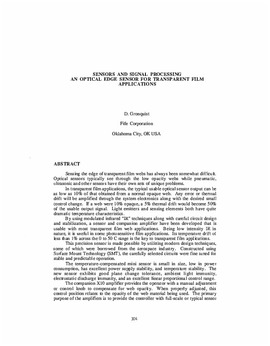| dc.contributor.author | Gronquist, D. | |
| dc.contributor.other | International Conference on Web Handling (1991) | |
| dc.date.accessioned | 2019-11-04T18:54:20Z | |
| dc.date.available | 2019-11-04T18:54:20Z | |
| dc.date.issued | 1991-05 | |
| dc.identifier | oksd_icwh_1991_gronquist | |
| dc.identifier.citation | Gronquist, D. (1991, May). Sensors and signal processing: An optical edge sensor for transparent film applications. Paper presented at the First International Conference on Web Handling (IWEB), Stillwater, OK. | |
| dc.identifier.uri | https://hdl.handle.net/11244/321657 | |
| dc.description.abstract | Sensing the edge of transparent film webs has always been somewhat difficult. Optical sensors typically see through the low opacity webs while pneumatic, ultrasonic and other sensors have their own sets of unique problems. | |
| dc.description.abstract | In transparent film applications, the typical usable optical sensor output can be as low as 10% of that obtained from a normal opaque web. Any error or thermal drift will be amplified through the system electronics along with the desired small control change. If a web were 10% opaque, a 5% thermal drift would become 50% of the usable output signal. Light emitters and sensing elements both have quite dramatic temperature characteristics. | |
| dc.description.abstract | By using modulated infrared "IR" techniques along with careful circuit design and stabilization, a sensor and companion amplifier have been developed that is usable with most transparent film web applications. Being low intensity IR in nature, it is useful in some photosensitive film applications. Its temperature drift al less than 1% across the O to 50 C range is the key to transparent film applications. | |
| dc.description.abstract | This precision sensor is made possible by utilizing modem design techniques, some of which were borrowed from the aerospace industry. Constructed using Surface Mount Technology (SMT), the carefully selected circuits were fine tuned for stable and predictable operation. | |
| dc.description.abstract | The temperature-compensated mini sensor is small in size, low in power consumption, has excellent power supply stability, and temperature stability. The new sensor exhibits good plane change tolerance, ambient light immunity, electrostatic discharge immunity, and an excellent linear proportional control range. | |
| dc.description.abstract | The companion X10 amplifier provides the operator with a manual adjustment or control knob to compensate for web opacity. When properly adjusted, this control position relates to the opacity of the web material being used. The primary purpose of the amplifiers is to provide the controller with full-scale or typical sensor levels regardless of web (10% to 100%) opacity. The operator adjustment procedure is quite simple and easily mastered. | |
| dc.format | application/pdf | |
| dc.language | en_US | |
| dc.publisher | Oklahoma State University | |
| dc.rights | In the Oklahoma State University Library's institutional repository this paper is made available through the open access principles and the terms of agreement/consent between the author(s) and the publisher. The permission policy on the use, reproduction or distribution of the article falls under fair use for educational, scholarship, and research purposes. Contact Digital Resources and Discovery Services at lib-dls@okstate.edu or 405-744-9161 for further information. | |
| dc.title | Sensors and signal processing: An optical edge sensor for transparent film applications | |
| osu.filename | oksd_icwh_1991_gronquist.pdf | |
| dc.type.genre | Conference proceedings | |
| dc.type.material | Text | |
